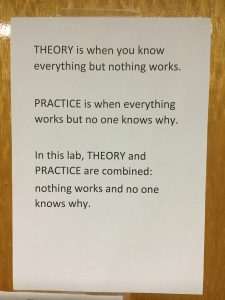
I am on an approved leave from teaching and university service this semester so that I can focus on research. While I’ve had a number of things going since before the New Year, the last two weeks have been the start of the “traveling” phase of my semester. For me, it’s “Phase 1” – I’ll be in Dallas for much of March while Jodi is away at the Pacific Northwest National Laboratory (PNNL). Now that this part of my semester has begun, I thought it would be useful to reflect on the last couple of weeks of “HEP Life.”
Working at the Argonne National Laboratory
Last fall, I was very fortunate to link up with colleagues at the Argonne National Laboratory in Lemont, IL to work on the ATLAS Fast TracKer (FTK) project. The FTK is a hardware system designed to quickly find all of the charged particle trajectories in a single “bunch crossing” inside the ATLAS detector at the Large Hadron Collider (LHC). When the LHC is running, a “bunch crossing” occurs every 25 nanoseconds (billionths of a second) and can yield about 40 proton-proton interactions all at once. Each proton-proton interaction can produce hundreds of charged particles, and so it is a challenging hardware task to then quickly find all of the trajectories of those particles from the highly granular silicon-based inner tracking systems. FTK is designed to do just this, and part of it will be deployed for the remainder of ATLAS Run 2 (starting in May) until Long Shutdown 2, at which point all of FTK will be fully installed for Run 3. A collaboration of scientists and engineers within ATLAS has been researching, developing, constructing, and now assembling the system over many years.
My graduate student and I are working on a small project, one my student (whom we’ll call “P”) is using to earn authorship on ATLAS. The goal is to develop software to monitor the health of the final stage of the FTK, called the “FLIC” – FTK-to-Level 2 Interface Card. The FLIC takes the final trajectory calculations from earlier in the FTK and then formats them for use in the software-based “High Level Trigger”, or HLT, system (formerly known as “Level 2″… so that now “FLIC” is actually a misnomer). Of course, for all of us this is a learning process of getting data onto the FLIC, getting data off of the FLIC, and then developing tools to check that data. P is making steady progress with a post-doctoral researcher at Argonne.
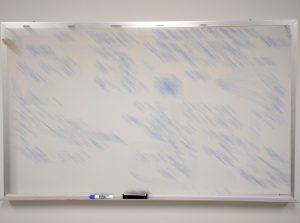
I had the pleasure to make a second trip to Argonne Feb. 7-9 to work with P and the post-doc and more generally interact with other members of the Argonne ATLAS group in their Analysis Support Center (ASC). It snowed while I was there, after a first day of quite warm temperatures.
My student and I discussed physics projects he could work on with a colleague at Argonne and while I was there P and the post-doc made further progress on communicating with the FLIC. I’ll be heading back to Argonne in March for another short trip. It’s been super-nice to be able to work with other colleagues on a time-sensitive and important project to the ATLAS detector itself, and I am thrilled to be able to collaborate on this for Run 2. I hope I can further that one day into future work on upgrades to the FTK, but that will take time and more collaboration to establish.
To CERN
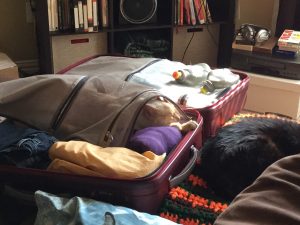
Right after returning from Argonne I packed up and headed to CERN. This begins the “leap-frogging” portion of my semester teaching leave, where Jodi and I miss each other for many weeks at a time while I am off to one place, then come home so she can go off to someplace else. This will continue until late July. It’s not great, but it’s #HEPLife. You can also see that our cats were not so thrilled about the idea of either of us popping off on trips again.
I actually had a fantastic trip to CERN. I connected through Madrid with a very, very long layover there. I have decided that I rather enjoy doing the Madrid connection, more so than my old London-Heathrow connection. The Madrid airport, while very very long and with terminals separated by great distances, is nonetheless much calmer than Heathrow and has a better food and shopping portion ringed by gates. I flew from Dallas to Madrid on a very new Boeing 787 – not the “Dreamliner,” but a smaller transcontinental jet, with 3-by-3-by-3 main cabin seating. The windows were not covered by shades, but instead were seamlessly built into the body of the plane and could be controlled with a push-button that changes the voltage in a gel in the window. As the voltage changes, the gel becomes more or less opaque. It was quite neat.
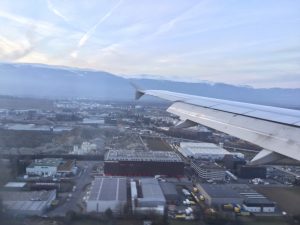
I got a solid 5 hours of sleep on the plane, which was not full, and I had a pleasant stay in Madrid waiting for my mid-afternoon connecting flight. I landed in Geneva around 5:30pm and made it to CERN by 7pm. That made grabbing dinner and going straight to bed quite simple, and I hit the ground running the next day.
This is a busy time for ATLAS. For the projects I am involved in – Higgs and bottom quark physics, bottom-quark-initiated jet triggers, and the FTK – everything is on-the-move. In Higgs and bottom quark physics, it’s time to do another production of the large cache of files we use for updating our analysis. I am in charge of this production, and this has mostly involved making sure people who pledged to serve as the production team launch their jobs on the global computing GRID, fix broken jobs, and bring completed files to the common group storage. It’s moving along fast. Sure, there have been glitches, but all of the hard work the team did in making code improvements and improvements to the procedure for running the code and production have paid off.
As for bottom-quark-initiated jet triggers, while we’re not taking data again until June there is lots to do. My other graduate student, call them “M,” is also working for ATLAS authorship and doing so by developing a “plot book” to help experts quickly assess the quality of trigger information for bottom-quark-initiated jets that are built from FTK tracks. Of course, the FTK won’t be ready to go until the summer, so for now this is based on simulation of the FTK. But M is making steady progress on developing the tools to make the plot book, tools any user could then run to make an assessment of trigger-able information from the FTK.
My senior student, call them “J,” is getting ready to defend their PhD thesis on March 1. This is always the most stressful time for a student as they move back from CERN to the US, while waiting for comments from their committee on their thesis and writing their defense talk. It’s always rough, and I’m trying to balance being the helpful adviser with being the necessarily critical adviser.
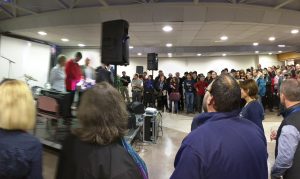
This is also a time of transition for the ATLAS Collaboration. Our leadership team is turning over at the top, with our previous Spokesperson and their Deputy Spokespeople stepping down and the new Spokesperson and his team stepping up. We gathered at CERN Restaurant 1 for a social event last Wednesday evening to bid farewell and give thanks to the previous leadership team and welcome the new one. It was a packed event; it was already ATLAS week, and representatives from 158 institutions were present along with many other members of those same institutions.
Looking ahead
Next week I will also be at CERN, and I return to Dallas on Feb. 25. Jodi heads to PNNL on the 26th, and the week that starts that day will be busy with my senior PhD student’s thesis defense. I am looking forward to one more solid week at CERN before I transition back home and resume the normal stresses of being back in the Department at SMU.

